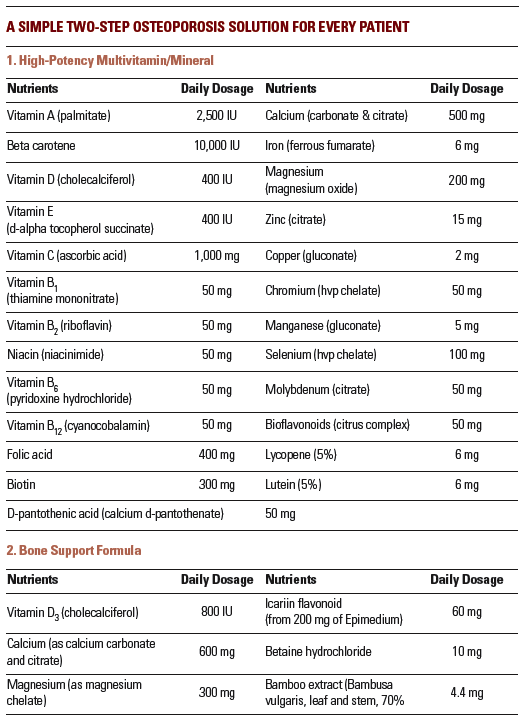In a landmark development, Blue Cross Blue Shield (BCBS) has reached a $2.8 billion settlement to resolve antitrust claims brought by health care providers, including chiropractors. The lawsuit accused BCBS of dividing the nation into exclusive regions and limiting competition, which resulted in lower reimbursements for providers. Although BCBS denies any wrongdoing, the company agreed to the settlement to avoid lengthy litigation – and you can get a piece of the pie.
Preventing and Reversing Osteoporosis: The Role of Supplementation
Recent evidence has shown that specific dosages of calcium, vitamin D and the icariin flavonoid (from the Epimedium herb) can not only prevent osteoporosis, but also reverse bone loss in individuals who already have osteoporosis. Quite conveniently, the supplemental dosages required to reverse osteoporosis are also the same dosages that are also shown to prevent this disease. This means that health practitioners should be providing the following recommendations to virtually all adult patients, whether or not they have osteoporosis, and whether or not they are already taking bisphosphonate drugs to treat osteoporosis. [Editor's note: Read "Long-Term Bisphosponate Use and Increased Fracture Risk" for related information.]
Our Responsibility in Osteoporosis Prevention and Management
Many of our patients view us as bone doctors. As such, a great deal of the responsibility for the prevention and management of bone loss in your patients falls on us. In regards to nutrition, the following intake levels of calcium, vitamin D and icariin flavonoid have been shown to prevent osteoporosis and can even help patients with osteoporosis regain some of their bone density back: calcium - minimum 1,500 mg (1,100 from supplementation; 500-900 mg is typically ingested via the North American diet); vitamin D - 1,200-1,400 IU; and icariin flavonoid: 60 mg (from Epimedium). Other bone-support nutrients of importance include:
- Magnesium - 500 mg
- Vitamin C - 1,000 mg
- Copper - 2 mg
- Zinc - 15 mg
- B-50 complex
- Silica - 2-3 mg
- Boron - 1.5 mg
Osteoporosis: The Magnitude of the Problem
Approximately one in four women and one in eight men over the age of 50 develop osteoporosis in our society. These are alarming statistics since an estimated 25 percent of individuals who sustain an osteoporotic hip fracture die within the first year from related complications. (In Canada, where I practice, more women die each year from the consequences of hip fractures than from the combined death rate from breast and ovarian cancer, according to the Osteoporosis Society of Canada).
In the United States, osteoporosis management remains a significant economic health burden that could easily be reversed if practitioners were more vigilant about ensuring that their patients ingest proven dosages of critical bone-support nutrients. Sadly, most people are not getting sufficient nutrients to support optimal bone strength and maintenance.
As a practitioner concerned with bone health, I encourage you to recommend that each of your patients take a high-potency multivitamin/mineral and a well-designed bone support formula beginning at age 16 to be sure they are getting the bone nutrients required for prevention and reversal of osteoporosis.

Reversal of Bone Loss With Supplementation: Recent Findings
Hitz, et al. (2007) showed that supplementation with 1,550 mg of calcium (from calcium carbonate) and 1,400 IU of vitamin D increased bone density in men and women over the age of 50 who had already sustained a bone fracture previously. These individuals gained bone density in the neck of the femur (a critical site for life-threatening fractures) and spinal vertebrae.
Zhang, et al. (also in 2007) showed that supplementation with 60 mg of icariin could increase bone density in postmenopausal women. After two years of supplementation, bone mineral density at the hip (femoral neck) and lower spine (lumbar) increased by 1.6 and 1.3 percent, respectively, in the icariin group, and decreased by 1.8 and 2.4 percent, respectively, in the placebo group.
Don't let your patients suffer the devastating consequences of an osteoporotic fracture. With your guidance, osteoporosis is preventable in almost every patient who enters your office. Be sure to discuss this issue with them before it's too late!
By providing patients with a simple two-step supplementation protocol, as outlined above, you can help prevent the devastating and sometimes life-threatening consequences of osteoporosis - a major health problem in modern society. It is also important to teach patients good dietary practices and to encourage weight-bearing exercise to complete the lifestyle management protocol for osteoporosis prevention and management. As well, regular chiropractic treatments help to keep the patient more functional, enabling them maintain pain-free movement patterns. This allows them to participate in physical activity at the level required for optimal osteoporosis protection.


